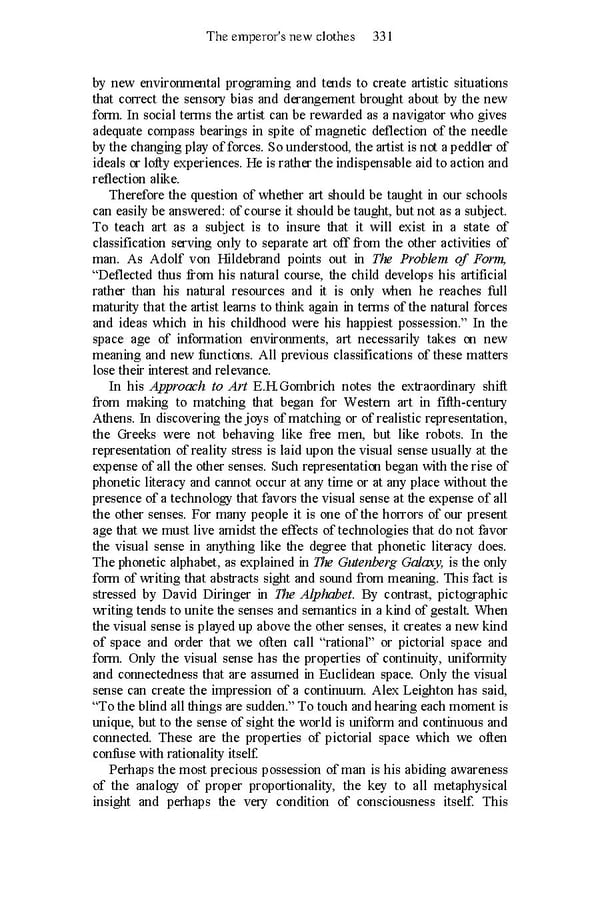The emperor's new clothes 331 by new environmental programing and tends to create artistic situations that correct the sensory bias and derangement brought about by the new form. In social terms the artist can be rewarded as a navigator who gives adequate compass bearings in spite of magnetic deflection of the needle by the changing play of forces. So understood, the artist is not a peddler of ideals or lofty experiences. He is rather the indispensable aid to action and reflection alike. Therefore the question of whether art should be taught in our schools can easily be answered: of course it should be taught, but not as a subject. To teach art as a subject is to insure that it will exist in a state of classification serving only to separate art off from the other activities of man. As Adolf von Hildebrand points out in The Problem of Form, “Deflected thus from his natural course, the child develops his artificial rather than his natural resources and it is only when he reaches full maturity that the artist learns to think again in terms of the natural forces and ideas which in his childhood were his happiest possession.” In the space age of information environments, art necessarily takes on new meaning and new functions. All previous classifications of these matters lose their interest and relevance. In his Approach to Art E.H.Gombrich notes the extraordinary shift from making to matching that began for Western art in fifth-century Athens. In discovering the joys of matching or of realistic representation, the Greeks were not behaving like free men, but like robots. In the representation of reality stress is laid upon the visual sense usually at the expense of all the other senses. Such representation began with the rise of phonetic literacy and cannot occur at any time or at any place without the presence of a technology that favors the visual sense at the expense of all the other senses. For many people it is one of the horrors of our present age that we must live amidst the effects of technologies that do not favor the visual sense in anything like the degree that phonetic literacy does. The phonetic alphabet, as explained in The Gutenberg Galaxy, is the only form of writing that abstracts sight and sound from meaning. This fact is stressed by David Diringer in The Alphabet. By contrast, pictographic writing tends to unite the senses and semantics in a kind of gestalt. When the visual sense is played up above the other senses, it creates a new kind of space and order that we often call “rational” or pictorial space and form. Only the visual sense has the properties of continuity, uniformity and connectedness that are assumed in Euclidean space. Only the visual sense can create the impression of a continuum. Alex Leighton has said, “To the blind all things are sudden.” To touch and hearing each moment is unique, but to the sense of sight the world is uniform and continuous and connected. These are the properties of pictorial space which we often confuse with rationality itself. Perhaps the most precious possession of man is his abiding awareness of the analogy of proper proportionality, the key to all metaphysical insight and perhaps the very condition of consciousness itself. This
 Essential McLuhan Page 337 Page 339
Essential McLuhan Page 337 Page 339